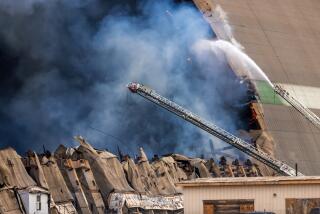It’s Big, It’s Red, It’s Tustin’s Own Pet Rock
- Share via
Strictly speaking, it’s not within Tustin, but it is Tustin’s landmark--a hill only 347 feet high and 1,000 feet long with rust-colored outcroppings that gave it its name: Red Hill.
Nowadays, it is the head of McClean Drive just northwest of Browning Avenue. Now a state historical landmark surrounded by homes, it still rises as the familiar prominence it has been since before recorded history.
American Indians called it Katuktu, meaning place of refuge. Their legend was that people gathered there to weather an epic flood and their campfires turned the hill red. Many artifacts have been found there, though no evidence of a permanent settlement.
The legend of a flood seems credible, for the area became very swampy after rains. One old-timer wrote of being able to row a boat from Red Hill to Balboa after a good rain.
The din of frogs led Spanish explorers to name the hill Cerrito de las Ranas or Frog Hill. It served admirably as a landmark along El Camino Real, in daylight because of its unique color, at night because of the noise.
The top of the hill was a boundary marker for the ranchos. “It’s not the highest hill around,” said Carol H. Jordan, author of “Tustin: City of Trees.” “It’s that it’s out by itself and it’s so reddish.”
By the time European settlement began, Mexicans had given the hill its present name, Cerro Colorado or Red Hill. The new settlers recognized the reason for the hill’s reddish hue: cinnabar, the ore that yields mercury. Several attempts were made to mine the ore, but they yielded too little profit to continue.
The surrounding area took its name from the hill, as did the road out of Tustin that ran nearby.
Lilian Martin Bruns recalled in the years after the turn of the century that the road was hot and dusty in the summer and fall and muddy in the winter. “But in the early spring, the fields were green with patches of Mariposa lilies, daisies and blue hyacinths. . . .
“When we reached the top of the hill we could smell the woodsy damp earth and ferns and the violets which grew in the shade between the rocks. . . . We sat in a bed of clover in the warm sun and had ‘jelly bread,’ apples and cheese. It was a little piece of heaven.”
Red Hill remains in private ownership and is zoned for half-acre estates, but according to county authorities, no plans for further development have been filed.
*
OC Then and Now calls, (714) 966-5973; e-mail OCthenand now@latimes.com.


